Watch the video above or read below.
Matthew Burns:
Stephen Semple and I are back for another Sticky Sales Stories. And this one is weird. A Canadian bank. With banks in general, let’s come on, be honest. We’ve seen insurance companies kick it, do some really good things. We’ve seen the big, big players. We’ve shown a bunch of stuff like that. We talked about our little bit of marketing knowledge that we have, because that’s what we do. But this is a Canadian bank, and banks don’t really tell good stories.
Stephen Semple:
They don’t tend to have great advertising.
Matthew Burns:
It’s like, how many people go to an accountant to get their marketing program built, right? That doesn’t really fit. But this is pretty cool. There are going to be images flying around the screen as we talk to this one. Steve, talk to me, man.
Stephen Semple:
A couple of things. This is an ad for the concept of fractional shares, which can be a difficult idea to explain. When TD started this advertising, TD was the first to offer fractional shares. Basically, what a fractional share means is you don’t even have to buy a full share. So, in other words, if the share is trading for $200, and you only got 20 bucks to invest, you can literally buy a small piece of a share, which also means you’re speaking to a lot of new investors. So how do you reach them? So they suddenly realize, great, wait, look, we all do stuff outdoors. So they wanted to reach them through outdoor advertising, through billboards,
Matthew Burns:
Through billboards, signage.
Stephen Semple:
Billboard signage, that sort of thing. Because guess what? We all do crap outdoors. But how do you convey that? But think about this now, fractional shares from TD Bank, I can own a small piece of a company. How do I advertise that? And on top of that, Apple, McDonald’s, and Nike may not allow me to use their logo. Like I always have to ask for permission on the logo. So, how do I convey that you can buy a fractional share of Nike without using the logo in outdoor advertising? That’s the challenge. Holy crap.
Matthew Burns:
And listen, guys, nothing has gone up on screen yet, and there’s a little bit of suspense play here, but we’re going to put a pause. We’re going to just put up a couple of images, and then we’ll come back. Perfect. Okay. Watch these. Let it roll.
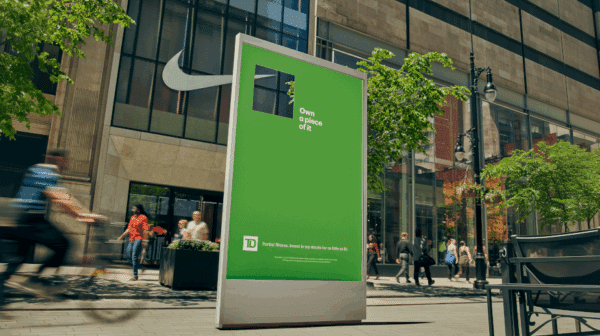
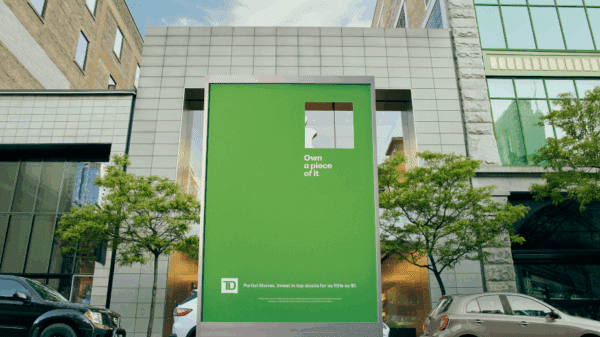
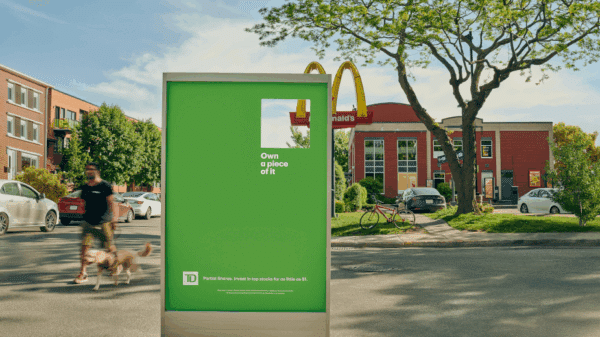
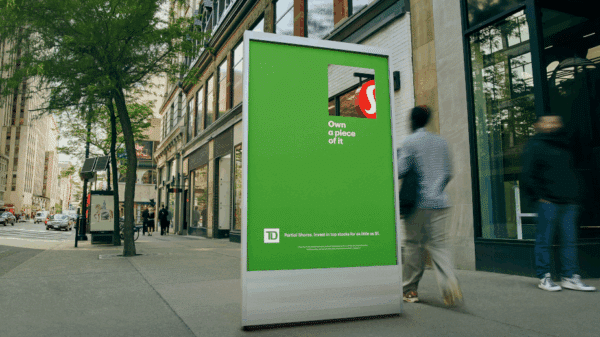
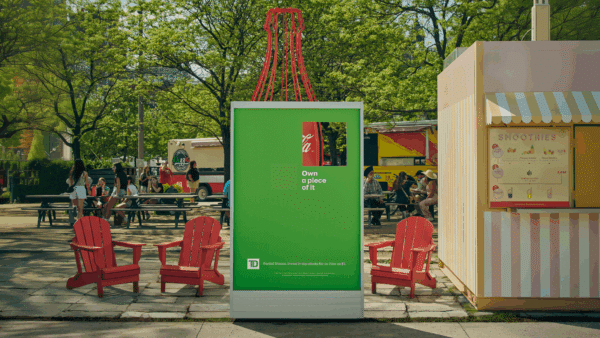
Stephen Semple:
Which also conveys this different fraction. I can now use the Apple logo, and I’ve talked to Apple about it. I’m not using the Apple logo..
Matthew Burns:
I just took a picture of my sign, guys. What are you talking about?
Stephen Semple:
Yeah. I thought it was an incredibly clever way of conveying a really complex topic in very few words. And they also leaned into this idea that we’ve seen McDonald’s do. McDonald’s has been doing this for a little while now with their billboards, where they’ll only show a portion of the arch. And what McDonald’s knows is we show a portion of the golden arch, they fill in the rest, they know it’s a golden arch. Same thing with that sign. You walk by and you see a little slice of the Apple logo. You know it’s Apple.
Matthew Burns:
Exactly. And I like it because they use international brands, which is great. So Apple, Nike, Starbucks, but they also use Tim Horton’s in the campaign and Lululemon, which I guess is international, but it’s a Canadian started brand from Vancouver. So the idea of being able to use frameline magnetism, which is a glamor play, and we should do an episode on glamor. Doing a glamor play, where you are not showing the whole thing and you’re letting the brain do the rest of the work, it draws you into the marketing, it draws you into the picture. It’s actually meant for photographs and a whole bunch of other things. To use glamor with banking. It just doesn’t seem right. But wait a second. Wait a second. Ogilvy, that agency had something to do with this.
Stephen Semple:
Oh, yeah. That was their campaign.
Matthew Burns:
Yeah. Guys, if you want to do something right, you find the absolute experts at the thing that you want done, right? And Ogilvy, obviously, I mean, they’re a massive company, a massive marketing firm, and they work with massive businesses like that. But come on, it was so meticulously thought out. How are we going to do all the things we need to do in the most simple form?
Stephen Semple:
When you think about that list I created at the beginning, here are the objectives to meet. It almost breaks your brain in terms of how to do it. That is how amazing this is. You could check all of those boxes.
Matthew Burns:
And they put it into a box. They literally made it into a square, dude. They made it into this big; it was so concise that it breaks my brain. You showed me, and I immediately went, yes. I didn’t even read through it. I went, yes, yes, yes, yes, yes. It’s interesting immediately; they nailed it.
Stephen Semple:
Yep. Brilliant. Well done.
Matthew Burns:
What, okay, so what’s the takeaway? How does somebody walk away from Sticky Sales Stories today and get something from this?
Stephen Semple:
So first of all, there are lots of creative things you can do without outdoor advertising. I love outdoor advertising. Outdoor advertising is great. The problem I have with most outdoor advertising is that it’s way too many words, and it’s just boring, and it’s way too much. You do need to do some creativity around it. You need to make your messages short, and you just have to really work to make that happen. But when you do that, outdoor advertising can be very effective.
Because also, outdoor advertising, when you measure it on a per-impression, repetition basis, it’s very inexpensive. A well-done billboard in a highly visible location gives you actually pretty good bang for your buck. The reason why a lot of businesses can’t use it is that it’s very difficult to distill it down to something as simple as that. But if you are able to, then outdoor advertising is really great. If you’re not able to, you need to look at other forms of advertising. But do not discount the power of outdoor advertising.
Matthew Burns:
Well, Jay Mistry, who is one of the Wizard of Ads partners and is an artist, has been working on our campaign for billboards, for Seaside Plumbing, and his last three boards were exactly that. And you know what? I’m going to throw them up. Yeah, they’ll intermix here.
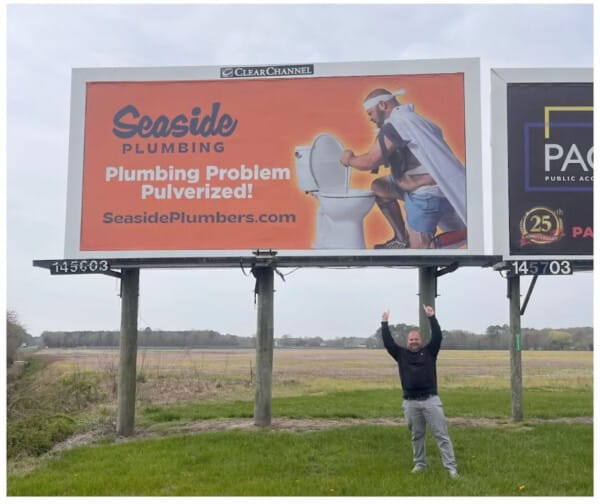
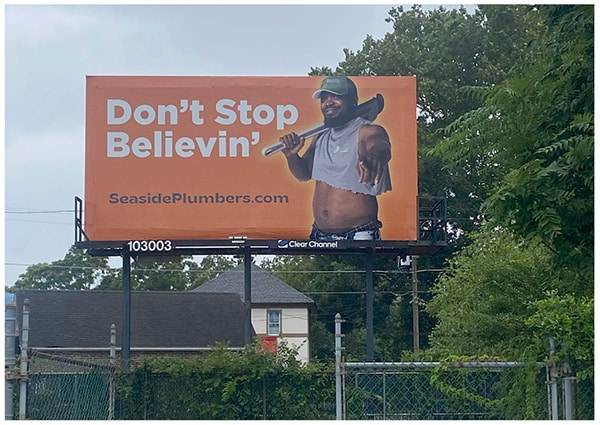
But guys, the idea of getting two or three words, five words, six words at max, maybe eight, if you really, really have to, that makes people feel something, makes them understand what you’re trying to get at right away. If you can do that, I think that’s what’s brilliant. What we said about the TD one, they made this big, massive concept with all of these complexities into the simplest form. That’s the thing. People don’t want to learn stuff. They want to know stuff.
Stephen Semple:
That is the creative challenge. The creative challenge is how to do this as simply as possible with as few words as possible. That’s the creative challenge for outdoor.
Matthew Burns:
Exactly. And listen, there’s some pride in this one, I’ve got to say. We’re both Canadian people, and it’s a Canadian bank, and we don’t think any banks have really done this very well. So way to go, TD, we’re really proud of you. Right.
- Brain Scans EXPOSE Samsung’s Brand Weakness - December 1, 2025
- They Thought Turning Vegas Into Disneyland Would Work… - November 12, 2025
- Why Visual Metaphors Still Dominate Modern Marketing - October 28, 2025
